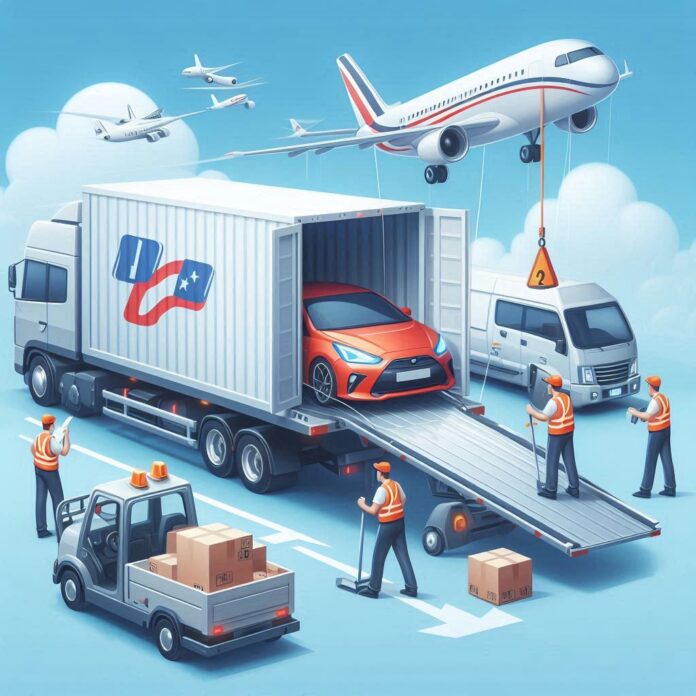
Imagine this: you’ve just bought your dream car in another state, or maybe you’re relocating across the country. One thing is certain — that prized vehicle needs to get to your new destination safely, securely, and on time. But how? That’s where car shipping steps in. It sounds simple — hand over the keys and wait for delivery. Yet, behind the scenes, there’s an entire process full of decisions, risks, and opportunities to save or overspend.

Whether this is your first time shipping a car or you’ve done it before, preparation is the secret weapon. From understanding the car shipping service industry to selecting a reputable auto shipping company, this guide gives you everything you need — including insider tips to avoid hidden fees, damaged cargo, or insurance nightmares.
And before diving into the logistics of the transport, don’t forget to verify Odometer with VIN. This quick step gives you access to a car’s true mileage history and protects you from future resale headaches or odometer fraud — a vital move especially when buying used cars online.
Understanding the Car Shipping Industry
The car shipping industry moves hundreds of thousands of vehicles across cities, states, and borders every year. From everyday sedans to luxury vehicles, this network connects buyers, sellers, and families on the move. Whether you’re relocating for work or sending a car to your college-bound child, you’re relying on an auto transport system that must be both reliable and transparent.
But the industry is diverse — not all auto transport companies are created equal. Some specialize in enclosed vehicle shipping. Others focus on international shipping. Knowing the difference is crucial.
How the Whole Process Works
Car shipping unfolds in a sequence: request quotes, compare services, schedule pick up, inspect the car, hand over the keys, and wait for delivery. It may sound routine, but each step deserves attention. The smallest mistake — missing insurance information or an unclear pick up date — can snowball into delays or disputes.
Choosing the Right Car Shipping Company
Online reviews tell stories. They expose whether a auto shipping company responds to claims, if it honors quotes, and how it handles unforeseen circumstances. Read them. Especially focus on Google reviews and bad reviews — they often reveal more than testimonials on a company’s own website.
Also verify the company’s liability insurance, cargo insurance, and whether they offer additional coverage for high-value car shipments.
Open vs. Enclosed Shipping: Which to Pick?
Open transport uses open auto trailers to ship multiple cars at once. It’s budget-friendly but exposes your car to weather and road debris. If you’re shipping luxury vehicles, enclosed auto transport is the safer bet. It provides full protection but at a higher cost.
Setting the Right Pick Up and Drop Off Expectations
A reputable auto shipping company offers both door-to-door and terminal to terminal service. The latter may be cheaper, but it requires you to drive your vehicle to and from centralized locations — not always ideal if you’re pressed for time or don’t live near major cities.
Plan the pick up date in advance. Car shipping companies can’t always guarantee exact timing due to traffic, driver schedules, and other factors. Flexibility helps, but always ask for a delivery window.
Understanding Car Shipping Prices
Car shipping prices vary. They depend on distance, season, type of transport (open vs. enclosed), and your car’s size and weight. Fuel costs, demand in certain regions, and other factors also play a role.
Always request multiple auto shipping quotes. Most companies will provide a range. Be cautious of any quote that seems too low — it often hides reduced insurance coverage, fewer guarantees, or even potential hidden fees.
How to Prepare Your Vehicle for Shipment
Step one: clean car. Not just for appearances — a clean vehicle makes it easier to inspect and document any existing dents or scratches before shipping. Take detailed photos of the vehicle’s condition from all angles.
Next, reduce the gas tank to a quarter tank. This lowers the vehicle’s weight and meets carrier requirements. Remove personal belongings and personal items — most shipping companies don’t insure them.
Insurance Coverage: What You Need to Know
The shipping company’s insurance certificate should cover basic liability and damage in transit. But read the fine print. Some types of damage, like from road debris or acts of nature, may not be fully covered.
If you’re transporting an exotic or rare model, additional protection is worth considering. Contact your insurer to explore options for supplemental insurance coverage that extends to car shipment.
Auto Transport Companies and Services
Some companies are brokers. Others are direct carriers. Brokers connect you with a network of car shippers but may not guarantee who will transport your vehicle. A direct auto transporter, on the other hand, handles the entire process.
Decide what you value more — flexibility and price (broker) or more control and reliability (carrier).
Top Car Shipping Tips from Industry Experts
- Ask about GPS tracking. It gives peace of mind.
- Don’t rely solely on online quotes. Speak to someone.
- Always confirm your vehicle registration is up-to-date.
- Avoid scheduling car transportation during major holidays.
- Understand your rights when it comes to insurance claims.
The Role of Auto Shippers in the Transport Chain
An auto shipper is the party actually responsible for transporting your vehicle — not necessarily the same as the company you booked with. That’s why it’s crucial to know whether you’re dealing with a shipping company or a broker.
Excellent. Here is the second part of your article, continuing the structure, keyword requirements, and writing style. This section brings the article to completion with the remaining subheadings, paragraphs, and the full FAQ.
Common Mistakes When Shipping a Car
Shipping a car isn’t something most people do often. That makes mistakes easier to make — and more expensive. One major error? Not reading the shipping contract. Another: assuming insurance coverage is full, when in reality it may exclude crucial events.
Also avoid packing personal possessions inside the vehicle. While it might seem convenient, most auto shipping services prohibit this due to insurance and weight limitations.
And finally, skipping the final inspection upon delivery is risky. Always compare the car’s condition against your original photos. Document any changes immediately.
Car Shipping Options Explained Simply
When it comes to auto shipping options, you’ll usually choose between:
- Open car trailers – most affordable, widely used
- Enclosed shipping – safer for expensive or classic vehicles
- Terminal-to-terminal – lower cost, less convenient
- Door-to-door – more expensive, but saves time and effort
What suits you best depends on budget, vehicle type, and how much time you’re willing to invest in the process.
Questions You Should Ask Your Car Shipping Company
Before signing anything, ask:
- What insurance info can you provide?
- How long will the car transportation take?
- What happens in case of delays?
- Is the pick up date flexible?
- Will I be informed of the driver’s progress?
These questions filter out unreliable services and help you spot a reputable auto shipping company.
Is Enclosed Vehicle Shipping Worth It?
Yes — in some cases. If you own vintage, exotic, or luxury cars, enclosed vehicle shipping prevents exposure to weather, dirt, and potential road debris. It’s pricier, but the peace of mind can be invaluable.
For standard sedans or SUVs, open transport may suffice. But again, check what kind of coverage the shipping company offers. Not all enclosed services guarantee full protection — read that insurance certificate.
What Makes a Reputable Car Shipping Company?
Experience, transparency, and responsiveness. A good company communicates clearly, provides honest auto shipping quotes, and doesn’t vanish after booking.
They explain liability, offer real tracking, and disclose potential hidden fees up front. When a company responds to customer issues — especially negative feedback — that’s a green flag.
Avoid companies with consistent bad reviews and no resolution records. The auto transport industry thrives on trust. Make sure they’ve earned it.
Moving Company or Auto Transporter?
Some people assume a moving company will handle their vehicle. But not all movers offer car transportation. Even when they do, they may subcontract it to an unknown third-party auto transporter.
When shipping vehicles, always deal directly with a specialized auto shipper. It ensures better pricing, better handling, and more accountability.
Your Driver’s Role in Car Transport
Once the driver arrives, they’ll inspect the car with you and note its condition on a bill of lading. This form becomes vital if you need to file insurance claims later. Sign only after confirming every detail.
While the driver is responsible for the car in transit, they don’t control traffic, breakdowns, or natural delays. Patience and clear communication go a long way.
Planning Around the Pick Up Date
The pick up date should be scheduled with a 2–5 day window in mind. Even the most reliable auto shipping company faces logistics challenges. Always plan for slight changes in schedule, especially if you’re in a remote area or dealing with international shipping.
Fuel and Cargo Tips Before the Haul
Leave just a quarter tank of gas. That’s enough to move the car but not so much that it adds unnecessary weight.
Also remove anything loose. Items in the trunk or cabin can bounce around during transport. Most companies forbid personal items inside the vehicle — doing otherwise might void your insurance coverage.
The Biggest Benefits of Using Auto Transport
Using a car shipper saves mileage, wear, and stress. Driving cross-country might seem cheaper, but when you calculate fuel costs, hotel stays, food, and potential mechanical issues — shipping a car becomes more attractive.
Plus, for snowbirds, collectors, or car buyers, the convenience and protection are the biggest benefits of all.
What Happens During Drop Off
At the drop off, inspect the vehicle again. Confirm it matches the condition noted during pick up. Pay close attention to tires, paint, lights, and undercarriage.
If anything seems off, raise the issue immediately. Signing the final paperwork means accepting the vehicle’s condition — and it limits your ability to file insurance claims later.
Shipping Your Car Internationally
International shipping requires additional documents: vehicle registration, driver’s license, and proof of ownership. Customs clearance, taxes, and inspections may apply depending on the destination.
Work only with companies that specialize in international vehicle shipping — they’ll handle logistics, compliance, and paperwork.
How Car Shipping Varies by Season
Shipping a car in summer or around holidays often costs more due to demand. Winter routes may face delays due to storms or icy roads. If flexibility allows, target shoulder seasons — spring and fall — for better car shipping prices and availability.
Your Car Ready Checklist
- Wash and photograph the vehicle’s condition
- Remove all personal belongings
- Empty down to a quarter tank
- Confirm your insurance information
- Check the company’s liability insurance
- Document pick up and drop off timelines
- Keep the bill of lading for records
Car Shipping Quotes: What They Really Mean
A low quote can mean minimal coverage or low driver pay — which increases the chance your car sits idle on dispatch boards. A high quote may include unnecessary services.
Aim for the middle ground: a clear, itemized quote with no hidden fees and transparent terms. Always confirm whether taxes and cargo insurance are included.
When Unforeseen Circumstances Arise
Weather, mechanical issues, and road closures affect timing. The best car shipping companies communicate early and often. If you face delays, stay in touch, keep documentation, and remain calm. Insurance claims, if needed, go more smoothly with solid records.
Conclusion: Smart Shipping Starts with Smart Choices
Car shipping may seem daunting at first glance — but armed with the right knowledge, it becomes a controlled, manageable process. Whether you’re moving across the country or sending a vehicle to a buyer, understanding the timeline, the costs, and your rights empowers you.
Choose your car shipping company wisely, prepare your vehicle thoroughly, and double-check the fine print on every contract. From pick up to drop off, transparency and preparation are your greatest allies.
FAQ: Uncommon But Important Questions About Car Shipping
- Can I leave valuable items hidden in the car during shipping?
No. Most companies strictly prohibit personal items and valuable items inside the vehicle due to liability and weight restrictions. - What if the auto transporter damages my car but denies responsibility?
If the damage is documented during pick up and ignored during drop off, use your photos, bill of lading, and insurance certificate to file a claim. Escalate if needed. - How do I know if I’m overpaying for car transportation?
Compare at least three car shipping quotes. If one is drastically lower, it may exclude essential services or insurance coverage. - Why does car shipping vary so much between companies?
Each company sets rates based on driver availability, route difficulty, fuel costs, and whether they’re brokers or direct carriers. - Can GPS tracking help with insurance claims?
Yes. GPS tracking provides real-time proof of route and delays — useful in case of disputes or insurance issues.





